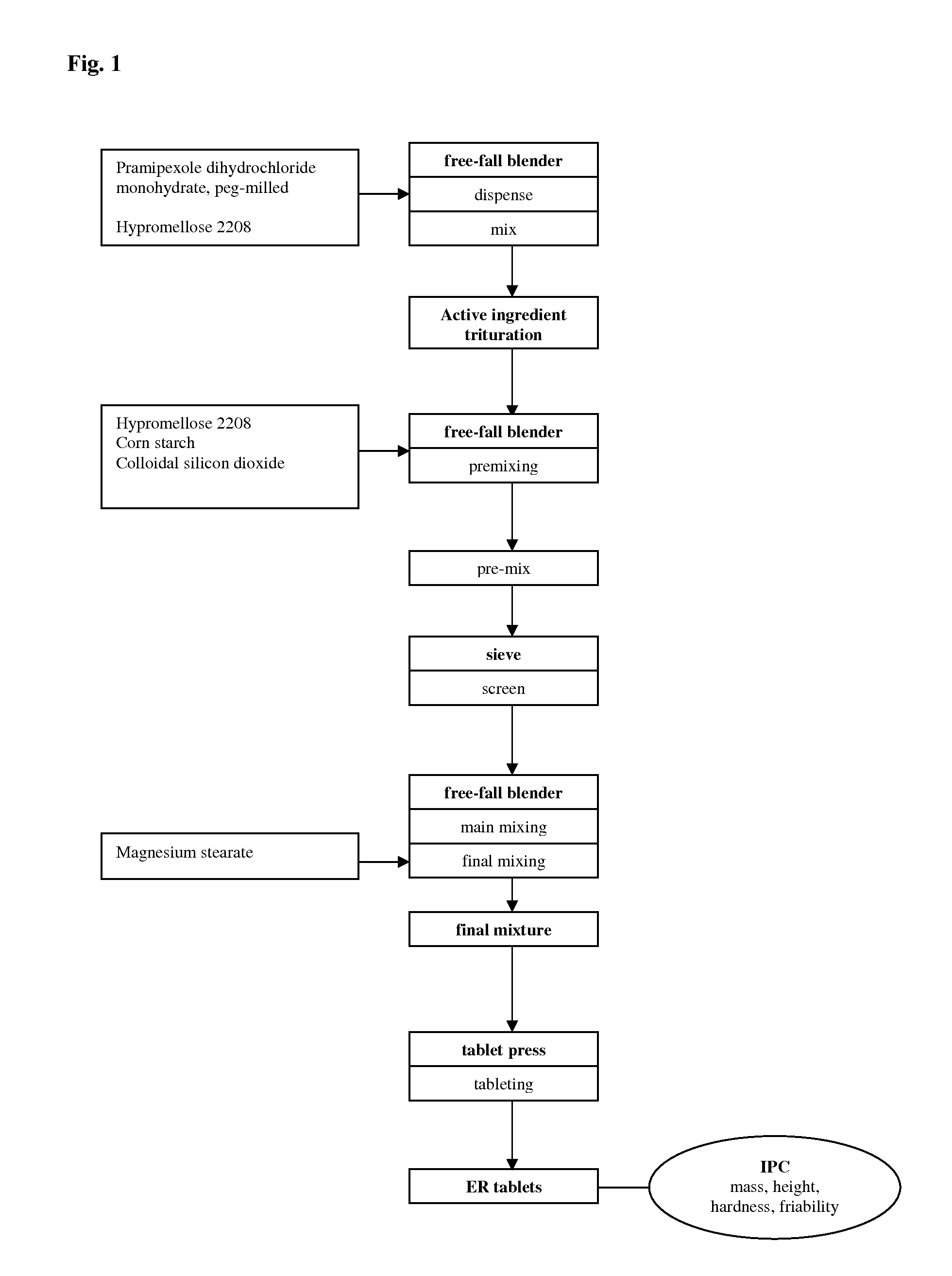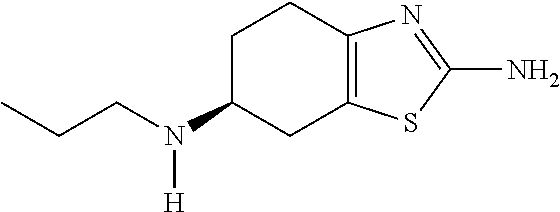Extended Release Formulation
a technology of extended release and formulation, which is applied in the field of extended release formulation, can solve the problems of difficult to formulate a suitable combination of modified and extended pramipexole tablets, and achieve the effect of stable drug plasma concentration, effective and tolerabl
- Summary
- Abstract
- Description
- Claims
- Application Information
AI Technical Summary
Benefits of technology
Problems solved by technology
Method used
Image
Examples
example 1
Preparation of Extended Release Composition
[0148]Extended release pellets were prepared, comprising pramipexole dihydrochloride monohydrate (0.91 wt.-%), microcrystalline cellulose (90.12 wt.-%), hydroxypropylcellulose (0.18 wt.-%), talc (0.79 wt.-%), ethylcellulose (6.40 wt.-%), and polyethylene glycol 6000 (1.6 wt.-%), by a two-step coating process starting from microcrystalline cellulose core pellets. In the first step, the core pellets were coated with an aqueous solution of the active ingredient and hydroxypropylcellulose as binder. In the second step, an organic solution of ethylcellulose and the plasticiser were applied. The pellets were filled in two-piece HPMC hard capsules (size 3); the amount filled per capsule was calculated to yield a strength of 0.75 mg of active ingredient.
example 2
Dissolution Testing of Extended Release Composition
[0149]Dissolution testing of the hard capsule composition prepared according to example 1 was conducted according to United States Pharmacopeia (USP) 28, chapter 711, using the same conditions and settings except for the composition and pH of the dissolution medium, which was varied between pH 1.3 and 7.3 (pH 1.3, 4.5, 6.8, and 7.3). Samples were taken after 1, 3, 6, 9, 12, 18 and 24 hours. In result, the average amount of drug released after 6 h was about 35%, after 12 h about 55%, and after 24 h about 70% of the incorporated dose. At no point of time, the difference in the released amount of drug between any of the dissolution profiles was more than 20% of the incorporated dose. Comparing the dissolution profiles at pH 4.5 and 6.3, there was no point of time at which there was a difference in the released amount of drug of more than 10% of the incorporated dose.
example 3
Pharmacokinetics of Extended Release Composition
[0150]The hard capsule composition of example 1 was tested in 10 human volunteers for its pharmacokinetic properties at a regimen of multiple once daily dosing and compared to a commercially available tablet of pramipexole dihydrochloride monohydrate but having immediate release characteristics. The tablet was administered using a regimen of three dosings per day. In result, the hard capsule formulation achieved a mean time to maximum plasma concentrations of pramipexole (tmax) of about 4.5 h. The mean average plasma concentration of pramipexole after reaching steady state was 0.47 ng / ml. Significantly, the fluctuation index as defined herein-above was substantially less than 100%, having a mean value of 57%. In contrast, the immediate release tablet exhibited a mean tmax of only about 2 h, and a mean fluctuation index of 104%.
PUM
| Property | Measurement | Unit |
|---|---|---|
| pH | aaaaa | aaaaa |
| solubility | aaaaa | aaaaa |
| solubility | aaaaa | aaaaa |
Abstract
Description
Claims
Application Information
 Login to View More
Login to View More - R&D
- Intellectual Property
- Life Sciences
- Materials
- Tech Scout
- Unparalleled Data Quality
- Higher Quality Content
- 60% Fewer Hallucinations
Browse by: Latest US Patents, China's latest patents, Technical Efficacy Thesaurus, Application Domain, Technology Topic, Popular Technical Reports.
© 2025 PatSnap. All rights reserved.Legal|Privacy policy|Modern Slavery Act Transparency Statement|Sitemap|About US| Contact US: help@patsnap.com


